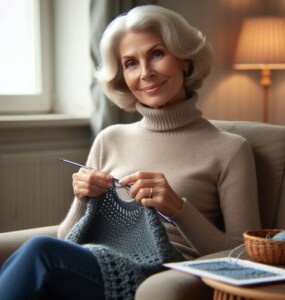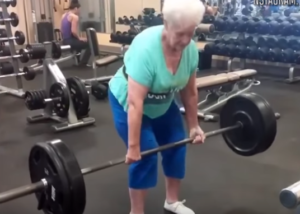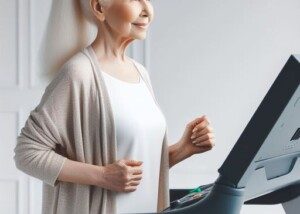There is a low back exercise that elderly people can do that will also significantly enhance their efficiency in daily living tasks. It is the deadlift.
I have yet to see a personal trainer having a senior citizen client doing a deadlift. When I was training people over 65 at a health club, I had them perform the deadlift motion.
The key here is the MOTION. The amount of weight on the bar can be as light as only five pounds.
The deadlift motion, performed with a very light weight for novice older people, can reactivate many dormant muscles.
It’s actually a safe exercise, even though it’s a competition event for powerlifting meets.
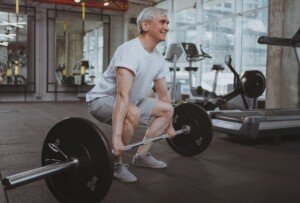
Shutterstock/Ihor Bulyhin
When performed with a light barbell that engages the entire body including the core, with the goal of improved fitness and mobility rather than winning a powerlifting meet — the deadlift is a lot safer than you may think.
This puzzles me, because the deadlift can be very safe for senior citizens when coached properly, and will go a long way in 1) helping prevent low back pain, and 2) alleviating existing low back pain.
Before you conclude that the defining characteristic of the deadlift exercise is hoisting up a very heavy thick barbell, you are very much mistaken.
The image below shows how to perform a deadlift. Don’t let the youth of the model deter you.
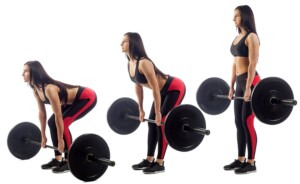
Shutterstock/Everyonephoto Studio
So very few senior age people do the deadlift, it shouldn’t be surprising that I couldn’t find a photo sequence of an elderly-looking man or woman performing this exercise. I found only stills.
A frail elderly person can do bodyweight-only deadlifts as a start. The progression could be holding a broomstick or holding a 2-pound dumbbell in each hand.
Elderly people desperately need to lift weights, and the deadlift is one of the best strength training routines because it works the entire body at once.
“Resistance exercise is a great way to increase lean muscle tissue and strength capacity so that people can function more readily in daily life,” says Mark Peterson, Ph.D., a research fellow in the University of Michigan Physical Activity and Exercise Intervention Research Laboratory, at the Department of Physical Medicine and Rehabilitation.
This fact applies to elderly people. Peterson adds: “Our analyses of current research show that the most important factor in somebody’s function is their strength capacity.
“No matter what age an individual is, they can experience significant strength improvement with progressive resistance exercise even into the eighth and ninth decades of life.”
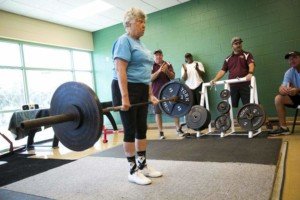
Trudy Daxon is of elderly age and just completed the top movement of the deadlift.
Hear that? If you’re in your 80s or 90s, it is not too late to reap benefits from lifting weights, and the deadlift – even with just your bodyweight – is a form of strength training.
Muscles worked include the front and back of the legs, upper back, middle back, shoulders, arms, and of course, the lower back.
A weak lower back is an impediment in many activities of daily living, as well as physical endeavors that senior citizens like to participate in, such as recreational hiking, wallyball, golf and bowling. A weak lower back will also become an issue during gardening.
Peterson endorses full-body exercises – exercises that engage more than one joint at a time (which means more than one muscle group at a time).
The deadlift is a very multi-joint exercise, tapping into the hip joints, knee joints and shoulder joints.
For elderly people who already go to a gym or health club, they should consult with a personal trainer to learn proper deadlift form.
However, the technique isn’t that far-removed from what people already do around the house; it’s just a modified (and safer) version.
Around the house, bending over to pick something weighted off the floor (such as a box of magazines, a cat, a toddler, a basket of laundry, a bucket of paint, a toolbox) yields a multi-joint motion that is similar to a deadlift. However, often, people use improper form and “throw their back out.”
As an elderly person gets stronger with the deadlift motion, he or she can advance to a 20-pound barbell if their gym has these.
A bare Olympic bar weighs 45 pounds. If that’s too heavy, dumbbells can be used.
But bear in mind that “Deadlifting 101” is not covered in medical school or in any hospital training.
So don’t be surprised if your physician has no idea what a deadlift is.
Ask if it’s okay to do strength training exercises that engage the lower back muscles.
Contraindications to strength training typically apply to intensity rather than to the type of motion.

